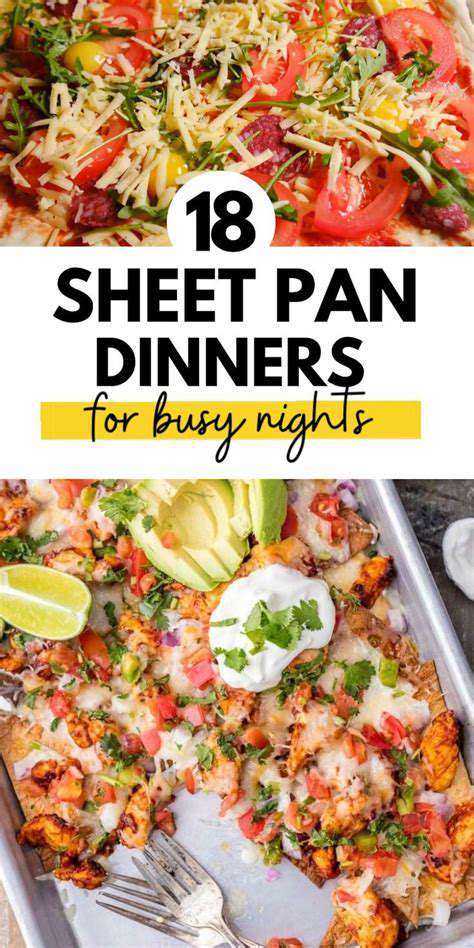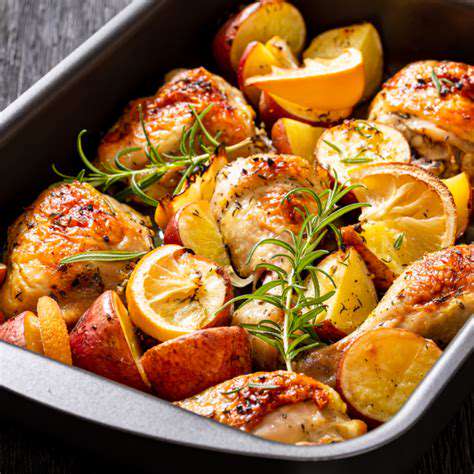Sheet Pan Dinners for Families: Easy Cleanup
Ingredient Variety for Flavorful Meals
Sheet pan dinners unlock a world of culinary creativity. Forget predictable chicken-and-veggie routines—try shrimp tossed with garlic butter, crispy tofu cubes, or Italian sausage paired with fennel. Rainbow bell peppers, tender asparagus spears, and caramelized sweet potatoes transform your pan into a vibrant canvas. The beauty lies in customization: swap ingredients weekly to keep taste buds intrigued without juggling multiple cookware pieces.
Elevate flavors with strategic seasoning. A rosemary-thyme duo whispers rustic charm, while smoked paprika and chili flakes ignite boldness. Tailor blends to your family’s palate—maybe a maple-Dijon glaze for kids or harissa paste for spice lovers. This intentional variety prevents flavor fatigue and turns weeknight meals into exploratory adventures.
Beyond the Typical Meat: Vegetarian and Vegan Options
Plant-powered sheet pan meals shine with minimal effort. Imagine jewel-toned beets and carrots drizzled with pomegranate molasses, or crispy chickpeas mingling with charred zucchini. Lentils roasted with cumin and coriander develop a meaty depth, while marinated tempeh cubes offer satisfying chew. These combos prove meatless doesn’t mean flavorless—just layer textures and umami-rich elements like miso or nutritional yeast.
Vegan adaptations require attention to detail. Coconut milk-based sauces mimic creaminess, while aquafaba (chickpea brine) can replace egg washes for crispy coatings. Always double-check cheese alternatives for hidden casein if serving strict vegans.
Mastering the Technique for Even Cooking
The golden rule? Give ingredients breathing room. Overcrowding steams instead of roasts, yielding soggy vegetables and pale proteins. If needed, split components between two pans—perhaps quick-cooking shrimp on one, dense potatoes on another. Rotate pans halfway through baking for uniform browning, especially in ovens with hot spots.
Parchment paper isn’t just for easy cleanup; it prevents delicate fish fillets from sticking. For extra crispness, place a wire rack on the pan to elevate ingredients, allowing heat to circulate underneath.
Easy Cleanup for Minimal Dishes
Here’s where sheet pan dinners truly outshine traditional cooking: one pan means one mess. Line with foil for zero-scrub cleanup, or embrace the caramelized bits by deglazing with broth for an instant pan sauce. Silicone mats are eco-friendly alternatives that withstand high heat while preventing stubborn residue.
Pro tip: While dinner bakes, soak used utensils in warm soapy water. By meal’s end, a quick swipe cleans everything, leaving more time for family connection.
Meal Prep Made Simple
Sunday prep turns weeknights effortless. Pre-chopped veggies stored in airtight containers stay crisp for days, while proteins marinate in ziplock bags, intensifying flavor. Assemble components on pans, cover with plastic wrap, and refrigerate until ready to bake—some combos even freeze well for longer storage.
Time-saving hack: Batch-roast neutral bases like potatoes and cauliflower. Later in the week, toss with different seasonings—one night Italian herbs, another night curry powder—for instant variety without extra prep.
Building authentic connections matters as much in professional networking as in personal bonds. First impressions act as relational blueprints, influencing every subsequent interaction. Whether meeting a CEO or a potential collaborator, intentional beginnings foster trust and open unexpected opportunities.
Delicious Sheet Pan Dinner Ideas: Fueling Your Family

One-Pan Wonders for Easy Weeknight Dinners
Sheet pan meals revolutionize time-crunched evenings. Their magic lies in simultaneous cooking—protein, veggies, and starch harmonize while you attend to other tasks. Mediterranean chicken with olives and lemon wedges or maple-glazed salmon with Brussels sprouts demonstrate how diverse 30-minute meals can be.
Secret weapon: High-smoke-point oils like avocado or grapeseed prevent burning at high temps, ensuring perfect sears without kitchen smoke alarms protesting.
Flavorful Combinations for Every Taste
Global inspiration elevates simple ingredients. Turmeric-roasted cauliflower with tahini drizzle channels Middle Eastern markets, while five-spice pork tenderloin with bok choy brings Asian flair. Even picky eaters succumb to honey-sriracha glazed chicken thighs with caramelized pineapple chunks.
Flavor-building trick: Add fresh herbs or citrus zest post-baking for vibrant top notes that cooked seasonings can’t replicate.
Healthy & Nutritious Options for a Balanced Diet
Roasting unlocks vegetables’ hidden sweetness, making them kid-approved. Kale chips baked alongside salmon become crispy nutrient powerhouses, while rainbow carrots roasted with thyme retain more vitamins than boiling. Always include a lean protein and complex carb (like quinoa or sweet potato) for sustained energy.
Dietary tweak: For keto followers, swap potatoes for radishes or turnips—they mimic spuds’ texture when roasted but with fewer carbs.
Simple Prep and Minimal Cleanup
The true victory? Avoiding the dreaded pile of pots. Even elaborate-seeming meals like Moroccan-spiced lamb with roasted eggplant require just one pan. Bonus: Many sheet pans transition directly from oven to table, doubling as rustic serving platters.
Space-saving tip: Nest mixing bowls used for tossing ingredients—they’ll take up less dishwasher real estate later.
Quick & Easy Recipes for Busy Weeknights
Some winners require mere minutes of active prep. Lemon-pepper cod with green beans cooks faster than takeout arrives, while pre-marinated supermarket meats (like teriyaki chicken) become lifesavers. Keep frozen vegetable blends on hand for zero-chopping emergency meals.
Efficiency trick: Set a kitchen timer when preheating the oven—it prevents getting distracted and wasting energy.
Making Sheet Pan Dinners Work for Your Family

Planning Ahead for Success
Strategic planning separates chaotic cooking from seamless execution. Color-coding your meal plan ensures visual balance on the plate—orange sweet potatoes, green broccoli, golden chicken. Note which veggies roast faster (asparagus) versus slower (potatoes) to stagger additions. Pre-measure spices into small containers for grab-and-go seasoning.
Advanced hack: Create a spreadsheet of family favorites with cooking temps/times for quick reference during hectic weeks.
Choosing the Right Ingredients
Ingredient selection follows the same surface, same fate principle. Pair quick-cooking shrimp with snap peas, not root vegetables. Hearty sausages can handle robust cabbage wedges, while delicate white fish suits tender zucchini. Always pat proteins dry before seasoning—this ensures proper browning.
Produce tip: Choose vegetables with similar densities. Soft mushrooms and firm carrots won’t roast evenly unless cut strategically.
Mastering the Cooking Technique
Temperature control makes or breaks sheet pan meals. 425°F (218°C) is the sweet spot—hot enough to caramelize, gentle enough to cook through. Use an oven thermometer to verify accuracy. For proteins requiring different doneness levels (like medium-rare steak and well-done potatoes), remove items incrementally.
Tool recommendation: Invest in a heavy-gauge aluminum pan—thin sheets warp at high heat, causing uneven cooking.
Balancing Flavors and Textures
Contrast creates excitement. Crispy prosciutto bits sprinkled over creamy polenta squares add salty crunch, while pomegranate arils on roasted squash introduce juicy bursts. Acidic elements like pickled shallots or yogurt sauce cut through richness.
Texture trick: Reserve some fresh herbs or nuts to garnish after baking—their raw crunch elevates softer roasted components.
Handling Leftovers Effectively
Transform leftovers strategically: Shredded roast chicken becomes tacos, while roasted veggies blend into frittatas. Store components separately to maintain textures—soggy reheated broccoli disappoints. Freeze sauces in ice cube trays for instant flavor boosts later.
Food safety note: Divide large quantities into shallow containers for rapid cooling, preventing bacterial growth.
Adapting to Dietary Needs
Inclusivity starts with smart substitutions. Nutritional yeast mimics cheese for dairy-free needs, while tamari replaces soy sauce in gluten-free diets. Roast tofu separately from meat to avoid cross-contamination. Always label allergen-free portions clearly.
Adaptation example: For nut allergies, use sunflower seed pesto instead of traditional pine nut versions.
- Storing Potatoes: Prevent Sprouting
- Healthy Meal Prep for Weight Loss: 5 Days of Deliciousness
- Exploring Italian Pasta Dishes: Beyond Spaghetti Bolognese
- Decadent Chocolate Chip Cookies: The Secret to Perfect Chewyness
- Cooking with Instant Pot Vortex: Air Fryer and More
- Quick Weeknight Meals: From Pantry to Plate
- Storing Rice and Grains: Pantry Best Practices
- Baking for Beginners: Easy Recipes to Master
- Instant Pot Basics: Quick & Easy Pressure Cooker Meals
- Discovering Brazilian Feijoada: A Hearty Stew
- Simple Pasta Dishes: Weeknight Wonders
- Authentic Greek Salads: Fresh and Flavorful